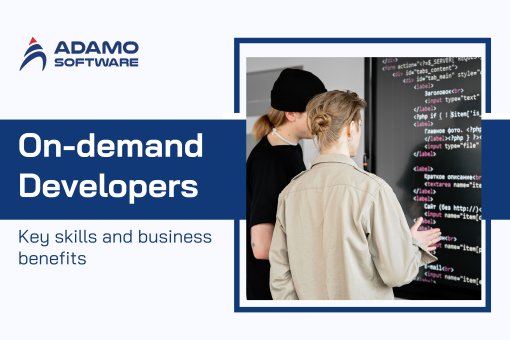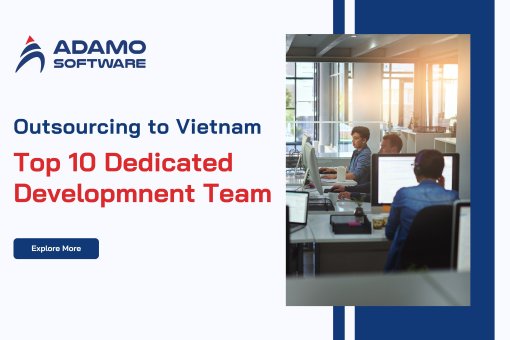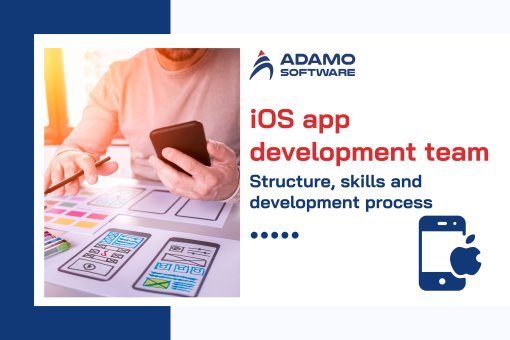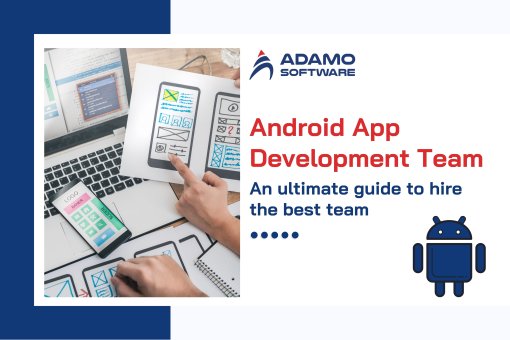
A comprehensive guide of 3 common IT outsourcing models and their pros and cons, when to use them: Project-based, Dedicated development team, Staff augmentation
As we enter 2024, the fast-changing world of IT outsourcing is greatly affecting global business. In this digital age, companies focus on the latest trends in software development and technology outsourcing. It’s like having a secret weapon that gives them an advantage in business.
Today, we’ll provide a comprehensive guide on models of IT outsourcing. We’ll go over 3 common IT outsourcing models and their advantages for your company.
I. IT Outsourcing Landscape of 2024
While some companies want employees back in the office, others are using remote work to access top talent worldwide. With remote teams, hiring isn’t limited by location, making IT outsourcing attractive for cost savings and finding scarce talent.
Besides, the tech sector faces a talent shortage due to retiring professionals and increased job complexity, making it hard for US companies to find the skilled workers they need. That’s why IT outsourcing has become easier and more advantageous.
In 2023, IT outsourcing hit a big milestone. The global market grew to $971.2 billion, a 22% increase from 2019. This growth was driven by the digital revolution, more enterprise apps, and the rise of remote work. Also, revenue in the IT outsourcing market is expected to reach $541.10 billion in 2024 (Statista, 2024)
II. 3 Common Types of IT Outsourcing Models
There are 3 common types of IT outsourcing models:
_ Project-based
_ Dedicated development team
_ Staff augmentation
1. Project-Based
Also called full-process outsourcing, this is the most popular IT outsourcing model. The IT vendor handles the entire project, including all stages, team management, results, and risks.
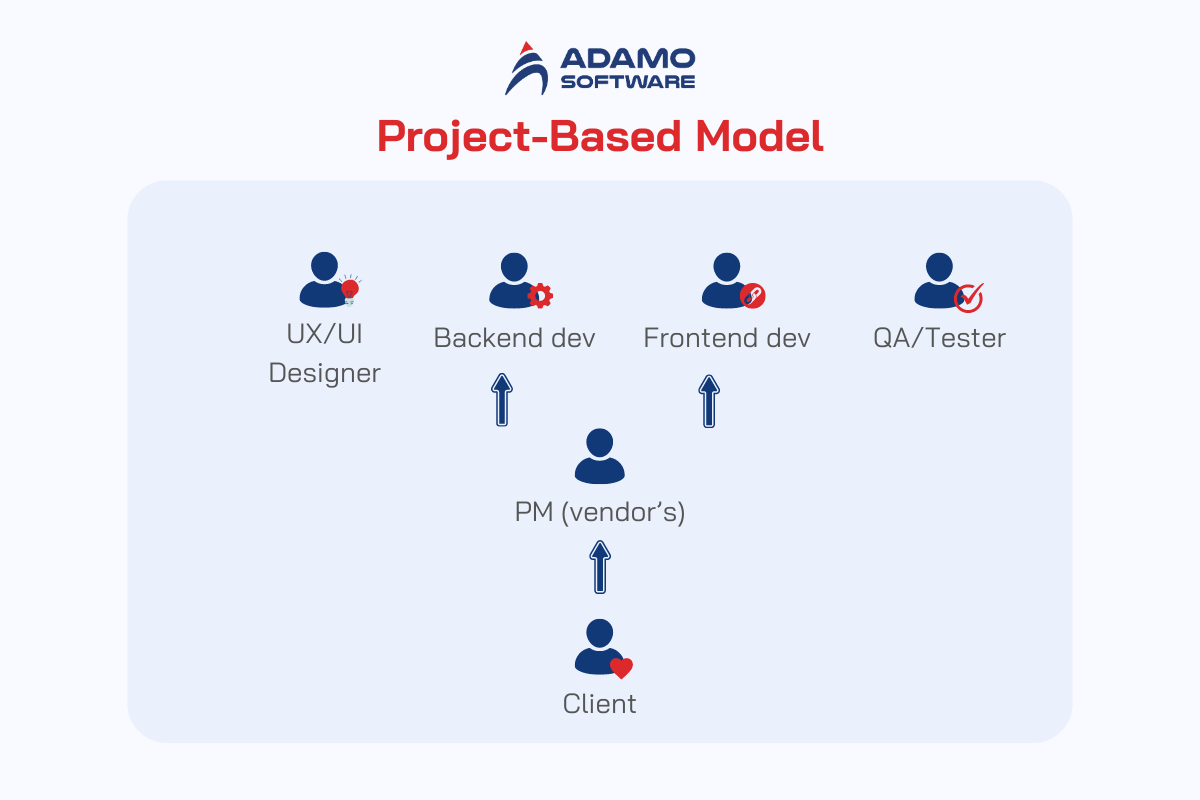
How it works: The client hires a team to carry out pre-planned work. The outsourced project manager is fully responsible for the project’s quality and performance.
Advantages:
_ Minimal client involvement, allowing focus on top-priority tasks.
_ Solid results and predictable outcomes, guaranteed by a Service Level Agreement.
_ Access to the IT vendor’s expertise, enabling the realization of complex ideas.
_ The vendor manages all risks and challenges.
Disadvantages:
_ The client has little control over the development process.
_ Project kickoff takes more time compared to other models.
When to use: This model is best for straightforward projects with predictable and well-understood functionality.
2. Dedicated Development Team
A dedicated development team is a cooperation IT outsourcing models where an outsourced team of developers works closely with the client’s team.
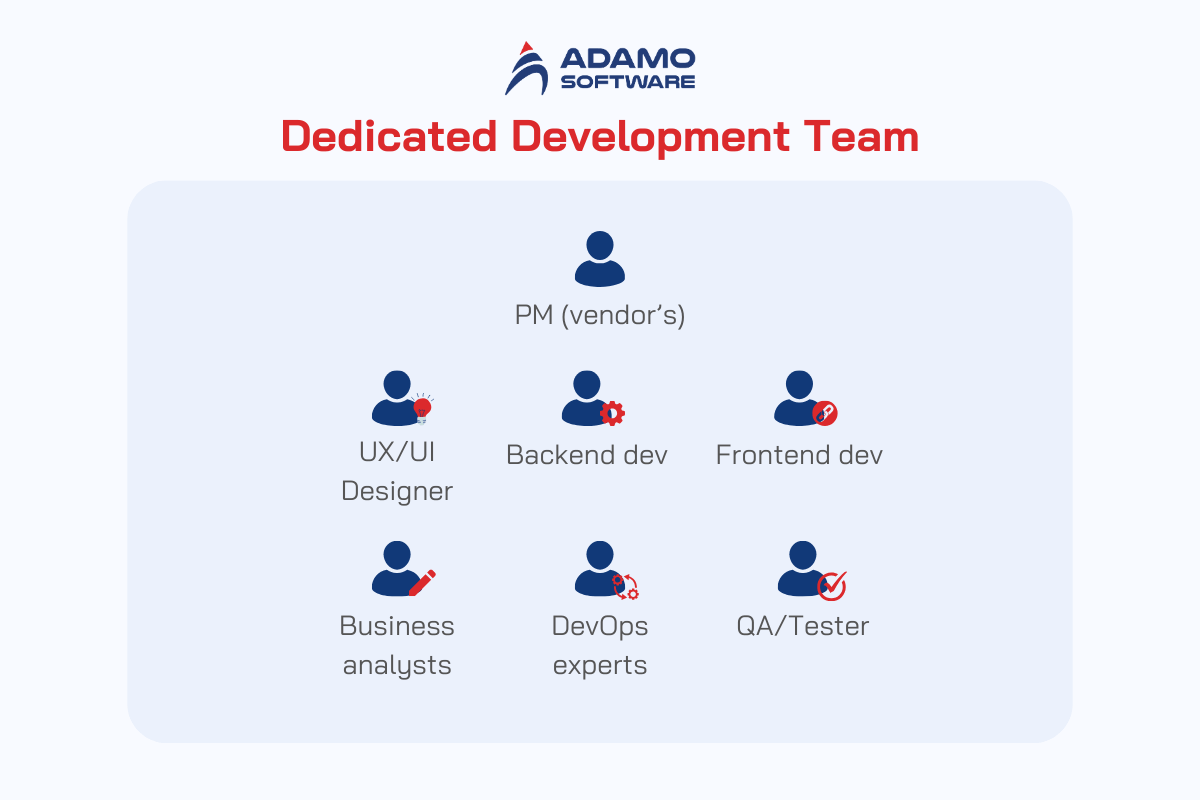
How it works: The client hires a team to work only on their project. Unlike the project-based model, a dedicated team is more involved in the project. They act as technical and product advisors, offering ideas and suggesting alternative solutions.
Advantages:
_ With a dedicated development team, you can focus on brand promotion, R&D, or scaling plans while handling your daily tasks.
_ A dedicated team works on one project at a time, improving speed and quality. You can adjust the team size as needed, and the outsourcing company will hire more people if necessary.
_ You won’t need to explain workflows or spend money on training because outsourced experts already know how to work remotely.
Disadvantages:
_ Setting up the kick-off may require some time as processes and workflows are being established.
_ There may be challenges related to communication and collaboration.
When to use:
You should consider hiring a dedicated team if you already have an in-house IT department and good procedures, but:
_ Your current team can’t handle the specific project.
_ The project needs skills your team doesn’t have.
_ You don’t want to hire new staff.
_ You want to be involved in decision-making.
3. Staff Augmentation
Staff augmentation refers to the utilization of external personnel for a limited period of time to enhance the capabilities of your business.
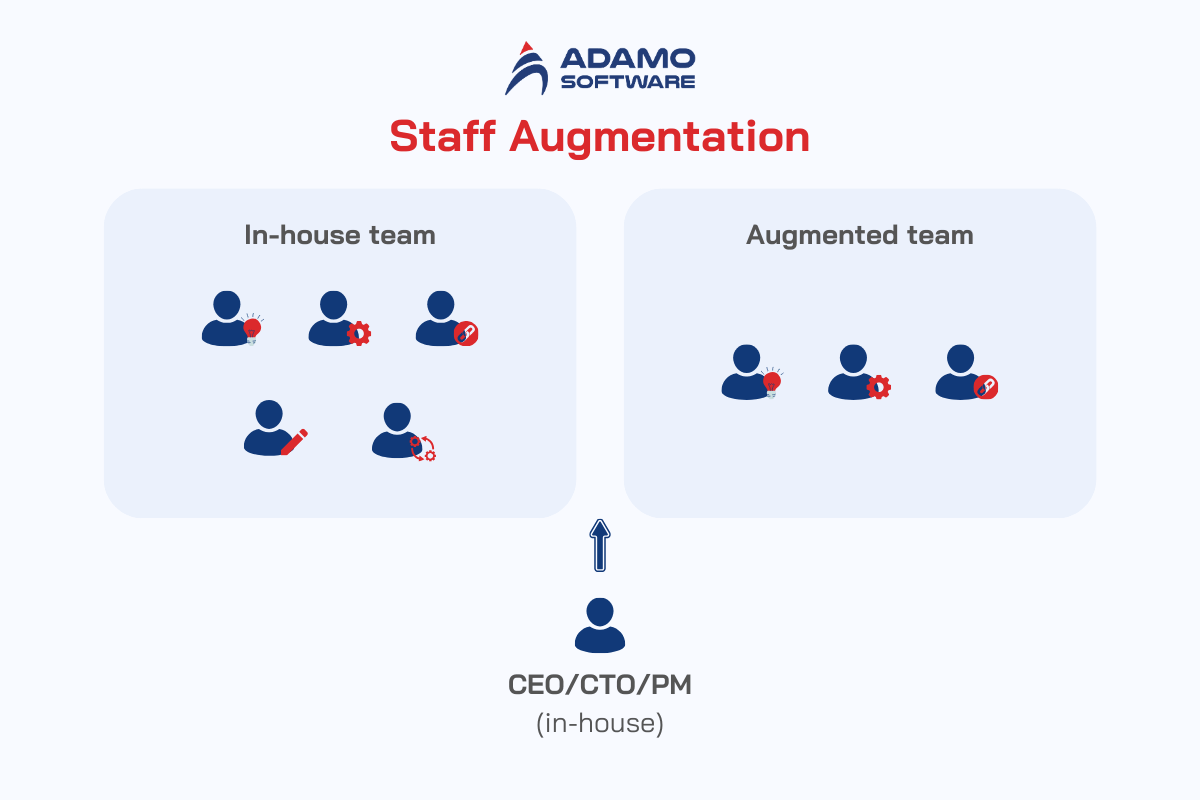
How it works: You hire individual specialists instead of a full development team. These external specialists work alongside your team to fill specific roles, with you remaining fully responsible for the project.
Advantages:
_ Flexibility and cost-efficiency, as you can add resources without hiring full-time staff.
_ Easy and quick team scaling based on your needs.
_ Access to skills your in-house team lacks.
_ Complete control over the project, with external experts working as part of your team.
Disadvantages:
_ You are responsible for all processes and deliverables.
_Potential cooperation and communication issues.
_ High risk of turnover among the extended staff.
When to use:
_ Staff augmentation is ideal for short-term projects or when you need extra hands to quickly scale your business.
_ You lack in-house resources and need extra help to develop a product.
_ You need specific expertise to build your product and require a team of product managers, designers, developers, and QAs.
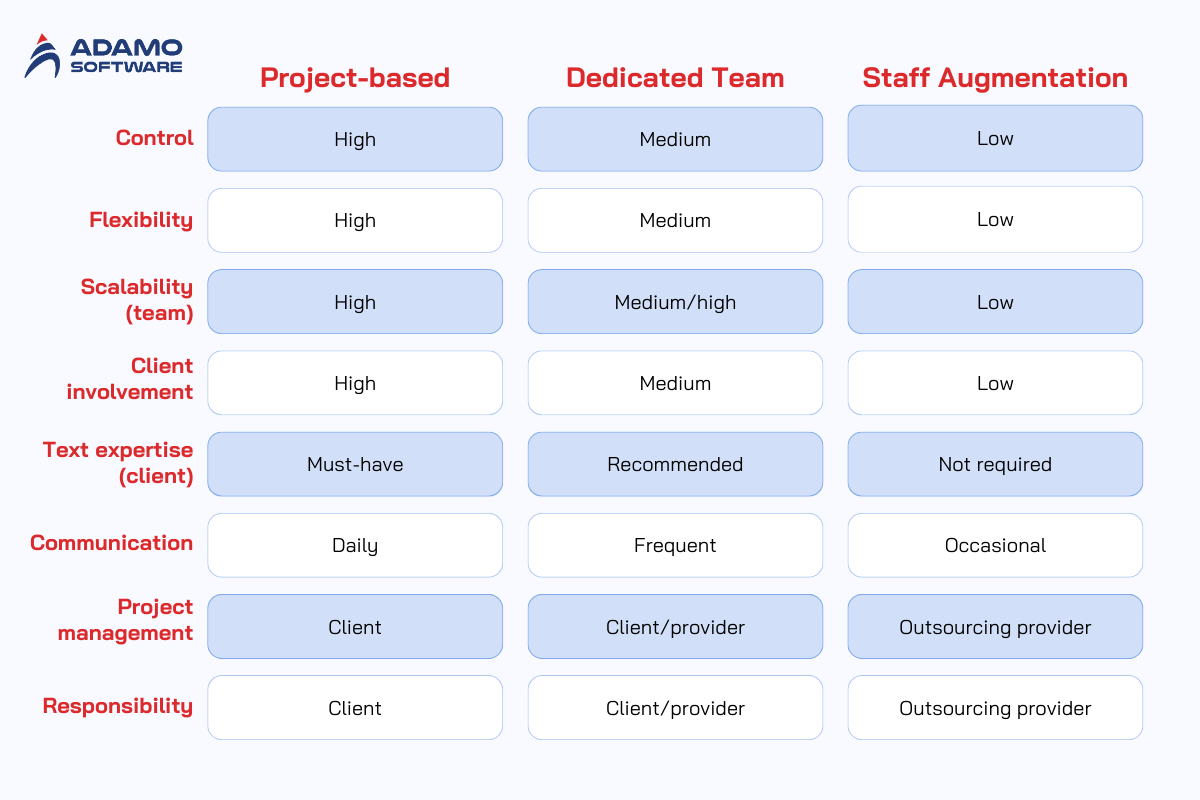
Also read: Offshore IT Outsourcing: What Is It, Pros & Cons, Top Destinations
III. IT Outsourcing Pricing/ Contractual Models
Regarding IT outsourcing pricing, usually, outsourcing service providers and clients use one of these pricing models:
1. Fixed Price
In the fixed price model, the price is set at the start and paid when major milestones are reached. The partner bears the financial risk, delivering the required service at the agreed price, regardless of resources used. Fixed price works well when requirements, scope, and goals are clearly defined.
A clear set of requirements and acceptance criteria is very important as it allows clients to evaluate deliverables properly. Besides, estimates are based on the initial analysis, which usually has a separate contract. Any changes in scope or deadlines require additional agreements.
2. Time and Materials (T&M)
In this model, payments are based on the time and materials needed for the project. That’s why this model suits flexible projects where the scope is hard to estimate or predict and is agreed upon before each billing period. It’s ideal for projects with many unknown variables. Clients are billed for the actual efforts of the team. Typically, the hourly rate for T&M is about 15% lower than for fixed price.
3. Dedicated Team Pricing
Another model of pricing is based on a dedicated team, the client pays a monthly fee based on the agreed rate for the team. This model is similar to the managed-team model in terms of cooperation. The hourly rate is generally lower than for T&M.
IV. How to Choose the Best Fitting IT Outsourcing Partner
There are many situations when IT outsourcing is an ideal option. You can consider outsourcing software development if:
_ You need time to focus on your core business.
_ Your in-house team lacks the necessary skills and expertise.
_ You need a one-stop solution for your software development project.
_ Your organization has limited resources.
_ You face time constraints and need the project completed quickly.
So, how to choose the best fitting IT outsourcing partner? Your decision depends on various factors and your specific needs.
1. Define your specific needs, goals, and requirements.
2. Decide which model best meets your technological needs.
3. Do research on different outsourcing models and partners to evaluate their qualifications.
4. Discuss project requirements and goals with your top choices.
5. Solidify your partnership with the best vendor.
6. Plan and start the project together.
Also, consider where to outsource development. Different regions offer varying expertise and costs. Generally, there are two options: nearshore and offshore.
V. Adamo’s Flexible IT Outsourcing Models – Why Choose Us?
Adamo Software is a premier software development company in Vietnam with many services from Web App development, AI services to Blockchain. With more than 120 successful projects in IT outsourcing, we have accumulated vast experience in a variety of industries such as Travel & Hospitality, Digital Healthcare, Fintech, Media and entertainment, F&B,…
At Adamo, we offer flexible IT outsourcing models, including team-based and project-based models, to serve a wide range of companies, from SMEs to multinational corporations. Our dedicated developers leverage the latest IT technologies to bring business ideas to life.
If you’re interested in learning more about IT outsourcing, seeking advice, or getting more information about Adamo Software, please feel free to contact us.







